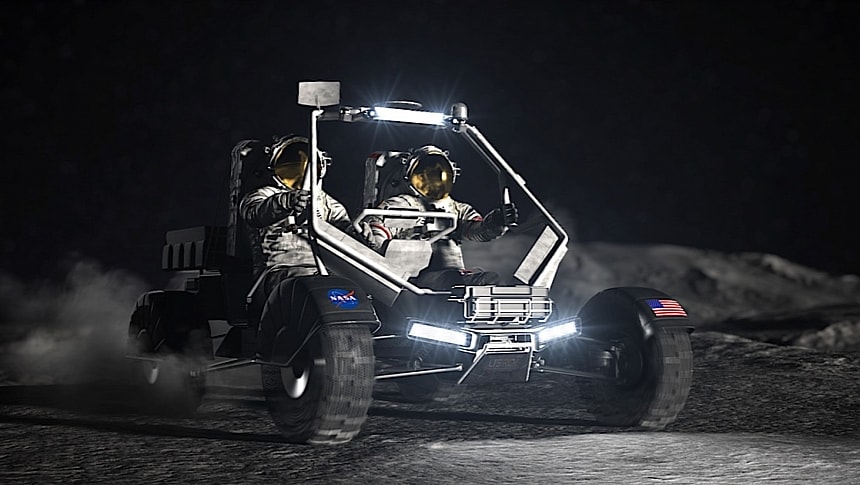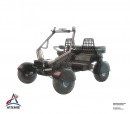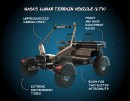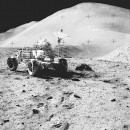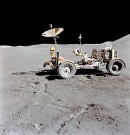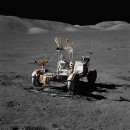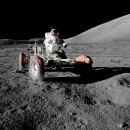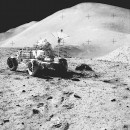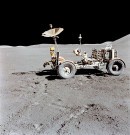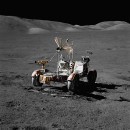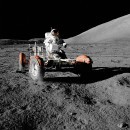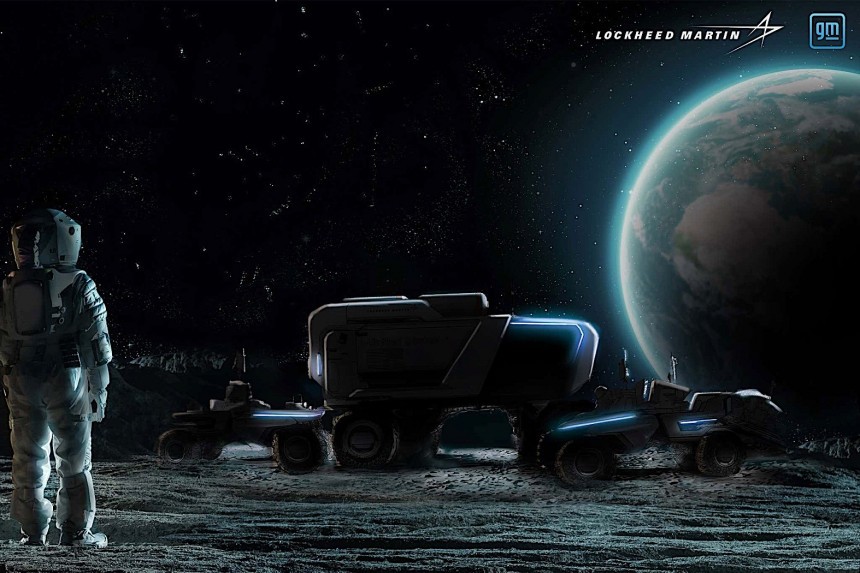Contrary to what one would have expected after American space agency NASA announced it is delaying the launch of the Artemis II and III mission by one year, work on making human presence on the Moon a constant seems to have accelerated. From rockets to all sorts of other systems, they all seem to be advancing at a great pace recently.
It was about four years ago when NASA gave us the first true look at something called the Lunar Terrain Vehicle. LTV for short, the vehicle is supposed to aid the astronauts of the Artemis V mission and beyond go further on the surface of Luna than all other previous crews.
Back in the days of the Apollo program the Boeing-made Lunar Roving Vehicle (LRV) was used beginning with the 15th mission of the program, helping people on the Moon cover distances of over 22 miles (35 km) on an area of 4.7 miles (7.6 km) around the landing site.
Not impressive, by any standards, but a lot more than what the crews of previous Apollo missions were able to cover on foot – just half a mile during a 20-hour stay on the surface of the satellite.
The astronauts going up on Artemis III and IV will not be gifted with a crew-rated vehicle, but the subsequent missions will be aided by the above-mentioned LTV.
It was in 2020 when NASA issued a couple of Requests for Information (RFI), asking interested parties for help in designing the next generation of "robotic mobility systems and human-class lunar rovers," of which the contraption is part.
And now, four years later, with a delay of about half a year compared to the proposed timetable (contract award was expected in November 2023) we are finally getting ready to learn the name of the company (or companies) that will be tasked with making the rover. NASA said this week it will announce the names of those involved on April 3, officially kicking into gear work on perhaps the most important extraterrestrial vehicle ever made.
Although they have not officially confirmed, several companies announced since 2020 that they are interested in making the vehicle, many of them joining hands for the gargantuan effort.
The first group comprises Lockheed Martin and General Motors, an association that blends carmaking skills with space expertise. The second one is made up of Teledyne, Nissan and Sierra Space.
Northrop Grumman, AVL, Intuitive Machines, Lunar Outpost, and Michelin are working together on their own, separate programs, as are Leidos and NASCAR. That's right, NASCAR.
The exact specifications of the vehicle are not known outside what NASA has already made public.
The vehicle has to be able to carry a crew of two people at a given time, but also cargo that may include "scientific instruments and technology demonstration payloads." For it to be able to perform its task, it will be equipped with two equipment racks located at both ends of the vehicle, and it will be rated as capable of carrying up to 500 kg (1,100 pounds), astronauts included.
The rover will be equipped with headlights to make the terrain ahead more visible, a navigation console for the people onboard to get their bearings, and communications equipment, including the kind that would allow remote operation. A series of mandatory sensors and cameras are also included in the package.
NASA never detailed the powertrain of the rover, but it did reveal it would have to be electric. Since there are no plugs on the Moon, its battery will have to be rechargeable "from internal power generation sources and from other lunar surface assets," including the lander.
No speed and range specifications are known at the moment, and our knowledge about the LTV's surface capabilities is limited to the requirement of being able to climb slopes of at least 15 degrees.
All the systems included in the machine will naturally have to be able to withstand the harsh temperatures usually encountered on the Moon, which generally range from 280 to minus 280 degrees Fahrenheit (138 to minus 173 degrees Celsius).
To make sure nobody misses the announcement on April 3, NASA will be holding a televised press conference on that day, at the Johnson Space Center in Houston. We will all be able to watch history unfold on the NASA+ website, on NASA television, in the NASA app, and on the agency's official website.
autoevolution will cover these events and we will report back with the hottest details on the Artemis Lunar Terrain Vehicle as soon as we know them.
And we're also kind of hoping the companies that will not be declared winners will share their designs as well, because we space enthusiasts can't have enough of things meant to be used on other worlds, even if they will not actually go anywhere.
Back in the days of the Apollo program the Boeing-made Lunar Roving Vehicle (LRV) was used beginning with the 15th mission of the program, helping people on the Moon cover distances of over 22 miles (35 km) on an area of 4.7 miles (7.6 km) around the landing site.
Not impressive, by any standards, but a lot more than what the crews of previous Apollo missions were able to cover on foot – just half a mile during a 20-hour stay on the surface of the satellite.
The astronauts going up on Artemis III and IV will not be gifted with a crew-rated vehicle, but the subsequent missions will be aided by the above-mentioned LTV.
It was in 2020 when NASA issued a couple of Requests for Information (RFI), asking interested parties for help in designing the next generation of "robotic mobility systems and human-class lunar rovers," of which the contraption is part.
And now, four years later, with a delay of about half a year compared to the proposed timetable (contract award was expected in November 2023) we are finally getting ready to learn the name of the company (or companies) that will be tasked with making the rover. NASA said this week it will announce the names of those involved on April 3, officially kicking into gear work on perhaps the most important extraterrestrial vehicle ever made.
The first group comprises Lockheed Martin and General Motors, an association that blends carmaking skills with space expertise. The second one is made up of Teledyne, Nissan and Sierra Space.
Northrop Grumman, AVL, Intuitive Machines, Lunar Outpost, and Michelin are working together on their own, separate programs, as are Leidos and NASCAR. That's right, NASCAR.
The exact specifications of the vehicle are not known outside what NASA has already made public.
The vehicle has to be able to carry a crew of two people at a given time, but also cargo that may include "scientific instruments and technology demonstration payloads." For it to be able to perform its task, it will be equipped with two equipment racks located at both ends of the vehicle, and it will be rated as capable of carrying up to 500 kg (1,100 pounds), astronauts included.
The rover will be equipped with headlights to make the terrain ahead more visible, a navigation console for the people onboard to get their bearings, and communications equipment, including the kind that would allow remote operation. A series of mandatory sensors and cameras are also included in the package.
No speed and range specifications are known at the moment, and our knowledge about the LTV's surface capabilities is limited to the requirement of being able to climb slopes of at least 15 degrees.
All the systems included in the machine will naturally have to be able to withstand the harsh temperatures usually encountered on the Moon, which generally range from 280 to minus 280 degrees Fahrenheit (138 to minus 173 degrees Celsius).
To make sure nobody misses the announcement on April 3, NASA will be holding a televised press conference on that day, at the Johnson Space Center in Houston. We will all be able to watch history unfold on the NASA+ website, on NASA television, in the NASA app, and on the agency's official website.
autoevolution will cover these events and we will report back with the hottest details on the Artemis Lunar Terrain Vehicle as soon as we know them.
And we're also kind of hoping the companies that will not be declared winners will share their designs as well, because we space enthusiasts can't have enough of things meant to be used on other worlds, even if they will not actually go anywhere.
